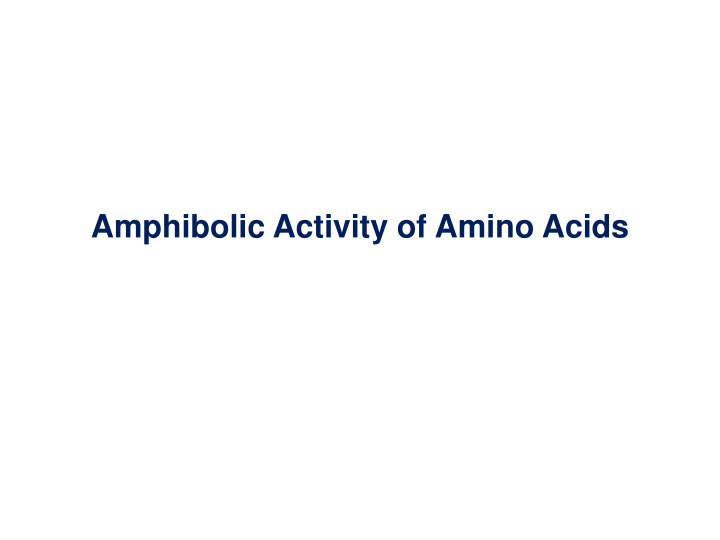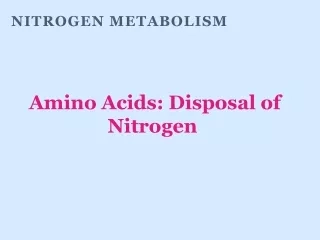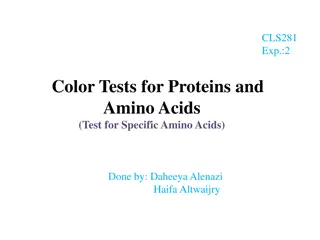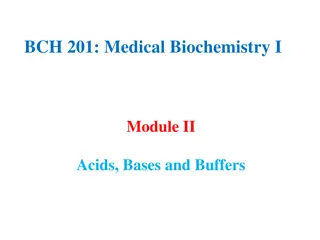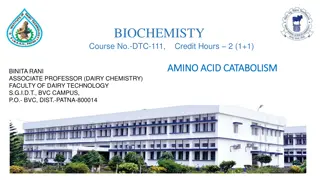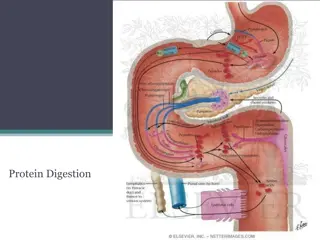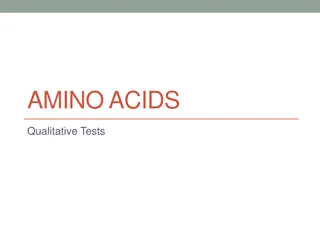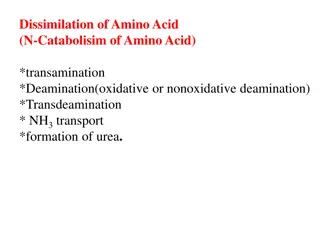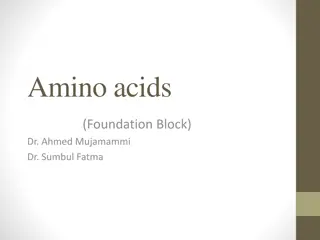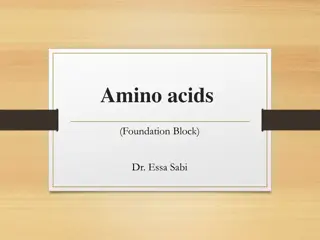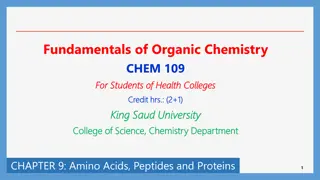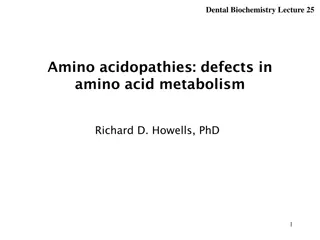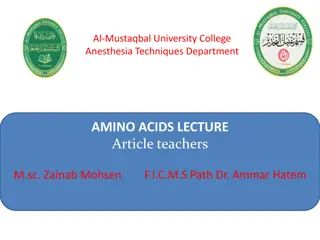Significance of Amino Acids in Biological Pathways
Amino acids play a crucial role as precursors in various biological processes, serving as building blocks for small molecules like hormones, coenzymes, nucleotides, and more. Glycine, a key amino acid, serves as the major precursor for porphyrins, essential in heme proteins. Understanding the pathways and biosynthesis of these molecules sheds light on their importance in metabolism and human health, like in porphyrias. Additionally, amino acids contribute to the synthesis of creatine, an energy buffer in skeletal muscle, showcasing their multifaceted role in biochemistry.
Download Presentation

Please find below an Image/Link to download the presentation.
The content on the website is provided AS IS for your information and personal use only. It may not be sold, licensed, or shared on other websites without obtaining consent from the author.If you encounter any issues during the download, it is possible that the publisher has removed the file from their server.
You are allowed to download the files provided on this website for personal or commercial use, subject to the condition that they are used lawfully. All files are the property of their respective owners.
The content on the website is provided AS IS for your information and personal use only. It may not be sold, licensed, or shared on other websites without obtaining consent from the author.
E N D
Presentation Transcript
Certain amino acids serve as precursors of many kinds of small molecules that have important and diverse biological roles, eg., Hormones, Coenzymes, Nucleotides, Alkaloids, Cell-wall polymers, Porphyrins, Antibiotics, Pigments, and neurotransmitters
Glycine is a precursor of porphyrins Glycine being the major precursor has the central importance beause of the porphyrin nucleus in heme proteins such as hemoglobin and the cytochromes Porphyrins porphobilinogen, molecules of aminolevulinate constructed which from four derived molecules from of itself is two There are two major pathways to Aminolevulinate Biosynthesis is regulated in higher eukaryotes by the concentration of the heme product, which serves as a feedback inhibitor Genetic defects in synthesis of porphyrins can lead to the accumulation of pathway intermediates, causing a variety of human diseases porphyrias known collectively as
Introduction to Heme Heme provides the iron- porphyrin group of hemoglobin It is the source of bile pigment It is degraded by two pathways When hemoglobin spleen, heme is released in erythrocytes are degraded in Heme is converted to biliverdin and finally to bilirubinn in the liver The precursor is synthesized from Succinyl Co-A glycine in higher eukaryotes and In plants algae and bacteria, the precursor for heme is synthesized from glutamate
Biosynthesis of precursor of Heme (Aminolevulinate)
Amino Acids Are Precursors of Creatine Phosphocreatine, derived from creatine, is an important energy buffer in skeletal muscle Creatine is synthesized from glycine and arginine methionine, adenosylmethionine, acts as methyl group donor S- in the form of
Biosynthesis of creatine and phosphocreatine
Amino Acids Are Precursors of Glutathione Glutathione are mostly present in plants, animals, and some considered as a redox buffer. bacteria, can be It is derived from glycine, glutamate, and cysteine. The carboxyl group of glutamate is activated by ATP to form an acyl phosphate.
Glutathione sulfhydryl groups of proteins in the reduced state and the iron of heme in the ferrous (Fe2) state, and it serves as a reducing agent for glutaredoxin in synthesis. probably helps maintain the deoxyribonucleotide Its redox function is also used to remove toxic peroxides formed conditions. under aerobic This reaction is catalyzed by glutathione peroxidase.
Precursors of Many Plant Substances Phenylalanine, converted to a variety of important compounds in plants tyrosine, and tryptophan are Tryptophan is also the precursor of the plant growth hormone indole-3-acetate. Phenylalanine and tyrosine also give rise to many commercially significant natural products such as morphine, flavouring of cinnamon oil , nutmeg, cloves, vanilla, cayenne pepper, and other products.
Biosynthesis of plant substances from amino acids
Biological Amines Are Products of Amino Acid Decarboxylation Many primary or secondary amines important neurotransmitters are Tyrosine catecholamines norepinephrine, and epinephrine. gives rise that to a family dopamine, of includes The disease underproduction of dopamine. neurological is disorder associated Parkinson s with an
Glutamate aminobutyrate neurotransmitter decarboxylation (GABA), gives an rise inhibitory to Polyamines such as spermine and spermidine, involved in DNA packaging, are derived from methionine and ornithine Ornithine enzyme, inhibitors used as pharmaceutical agents decarboxylase, the target a several PLP-requiring powerful is of
Arginine Is the Precursor for Biological Synthesis of Nitric Oxide Role of nitric oxide (NO) acts as an important biological messenger. This simple gaseous substance diffuses readily through membranes. In humans NO plays a role in a range of physiological processes, including neurotransmission, blood clotting etc. Nitric oxide is synthesized from arginine in an NADPH- dependent reaction catalyzed by nitric oxide synthase.
Each subunit of the enzyme contains one bound molecule of each of four different cofactors: FMN, FAD, tetrahydrobiopterin, and Fe3heme. NO is an unstable molecule and cannot be stored. Its synthesis is stimulated by interaction of nitric oxide synthase with Ca2-calmodulin.
Biosynthesis of spermidine and spermine. Polyamines such as spermine and spermidine, used in DNA packaging, are derived from methionine and ornithine The first step is the decarboxylation of ornithine, a component of the urea cycle and a precursor of arginine Ornithine decarboxylase is a PLP-requiring enzyme and is the target of several powerful inhibitors developed commercially as pharmaceutical agents
